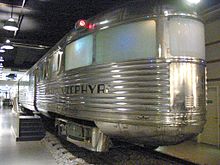Pioneer Zephyr
The Pioneer Zephyr is a diesel-electric railcar, with cars permanently linked by shared bogies, built by the Budd Company in 1934 for the "Chicago Railroad, Burlington and Quincy" (Chicago, Burlington and Quincy Railroad, acronym: CB&Q), familiarly called Burlington. The train, whose external appearance is highlighted by the use of stainless steel, was initially called Céfiro (Zephyr) and its initial destination was the promotion of passenger trains in the United States. The construction of the train included innovations such as shock welding, to join the stainless steel sheets and joints to reduce the weight of the train.
On May 26, 1934, he set the time record for a trip between Denver, Colorado, and Chicago, Illinois by covering the 1,015 miles (1,633 km) non-stop in 13 hours 5 minutes with an average speed of 124 km /h (77 mph). In a sector of the route it reached up to 181 km/h, 5 km/h below the world speed record for trains of the time. This historical tour inspired two films and earned it the name "Silver Streak" (silver mark).
The rail branch entered regular service on November 11, 1934 between Kansas City, Missouri, Omaha, Nebraska, and Lincoln, Nebraska. It operated on this route until its retirement in 1960 and was donated to the Museum of Science and Industry (Chicago), where it remains outside and is part of the aerodynamics exhibit. This type of train is generally credited with pioneering streamlined train design in the United States.
Design and construction
In the early 1930s, the United States was immersed in the Great Depression and rail transport suffered a decline in the number of passengers who used it compared to the previous decade. Additionally, passenger trains were essentially the same since the mid-XIX century, so the concept of train needed to be revised. of passengers.
Entrepreneur Ralph Budd decided to take up the renovation challenge. He had run the Great Northern Railroad railroad and now ran the Chicago, Burlington and Quincy Railroad (CB&Q), which needed a new train to encourage travel. back to the passengers. The name of the train was inspired by the Canterbury Tales, from a story in which Zephyr, the kind and nurturing west wind, is mentioned. Budd thought that Zephyr would be an excellent name for the train he wanted to build.
In 1932 Ralph Budd met Edward G. Budd (no relation), a pioneer of the automotive steel industry and founder of the Budd Company. Edward Budd demonstrated his new construction line with a locomotive made of stainless steel. Stainless steel had many advantages over the wood and hardened steel traditionally used for carriage structures. It was a lighter and stronger material, and its natural appearance and resistance to corrosion saved it from having to paint it to protect it from the rain. As the structure of the wagons is lighter, the weight per wagon could be increased, improving the profitability of each trip.
The problem with using stainless steel was that there was no suitable type of weld to join the pieces together, until the Budd Company patented the technique of shock welding. On August 20, 1932, Earl J. Ragsdale, an engineer with the Budd Company, applied for a patent for a "Method and Process of Electric Welding." On January 16, 1934, the United States Patent and Trademark Office awarded the Budd Company patent No. 1,944,106 on the aforementioned technique. Due to the nature of traditional welding methods, they did not produce sufficiently strong joints. With shock welding, the two pieces of metal were pressure joined and then welded with an electrode on each side of the joint. A very high electric current was passed that produced the fusion of the two pieces.
Another factor that contributed to lightening the Zephyr was the use of bogies between every two wagons (shared bogies) instead of having two sets of wheels per wagon. The train consisted of three articulated compartments. The articulated design also reduces weight by eliminating inter-car couplers.
The first Zephyr was completed by the Budd Company on April 9, 1934; It was powered by a Winton machine, model 8-201-A with 8 cylinders and 600 horsepower. This machine fed an electric generator which in turn powered electric traction motors connected to the axles of the motor vehicle.
The exterior design of the train was done by aeronautical engineer Albert Dean, who designed the sloped shape of the front of the train; he worked in collaboration with architect John Harbeson and industrial designer Paul Philippe Cret, who found a way to give strength and elegance to the sides of the train.
The train engineer stayed in a small cabin forward of the power unit. In the first car was the postal section, followed by the baggage section and a small dining section with 20 seats for passengers. The third car in its original design had room for 40 seats followed by a viewing area at the end with capacity for 12 passengers. In total the Zephyr could carry 72 passengers and 22.7 tons of cargo.
The Budd Company built, with the technology developed for the Zephyr, some variants for other railway companies (such as the Flying Yankee) and other units of the Zephyr for the Burlington line.
Contenido relacionado
Pad printing
Thermocouple
Capsule




